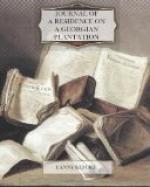A transaction of the most amusing nature occurred to-day with regard to the resources of the Darien Bank, and the mode of carrying on business in that liberal and enlightened institution, the funds of which I should think quite incalculable—impalpable, certainly, they appeared by our experience this morning.
The river, as we came home, was covered with Ocone boxes. It is well for them they are so shallow-bottomed, for we rasped sand all the way home through the cut, and in the shallows of the river.
I have been over the rice-mill, under the guidance of the overseer and head-man Frank, and have been made acquainted with the whole process of threshing the rice, which is extremely curious; and here I may again mention another statement of Miss Martineau’s, which I am told is, and I should suppose from what I see here must be, a mistake. She states that the chaff of the husks of the rice is used as a manure for the fields; whereas the people have to-day assured me that it is of so hard, stony, and untractable a nature, as to be literally good for nothing. Here I know it is thrown away by cart-loads into the river, where its only use appears to be to act like ground bait, and attract a vast quantity of small fish to its vicinity. The number of hands employed in this threshing-mill is very considerable, and the whole establishment, comprising the fires and boilers and machinery of a powerful steam engine, are all under negro superintendence and direction. After this survey, I occupied myself with my infant plantation of evergreens round the dyke, in the midst of which interesting pursuit I was interrupted by a visit from Mr. B——, a neighbouring planter, who came to transact some business with Mr. —— about rice which he had sent to our mill to have threshed, and the price to be paid for such threshing. The negroes have presented a petition to-day that they may be allowed to have a ball in honour of our arrival, which demand has been acceded to, and furious preparations are being set on foot.




